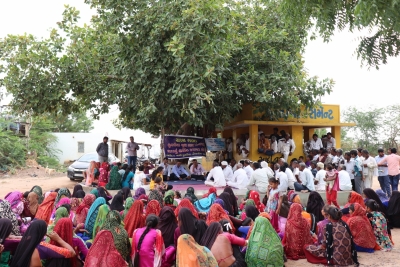PAI Version 2.0 to ensure data-based monitoring, planning at gram panchayat level
By IANS | Updated: May 24, 2025 17:03 IST2025-05-24T16:56:21+5:302025-05-24T17:03:00+5:30
New Delhi, May 24 The Panchayat Advancement Index (PAI) Version 2.0 is aimed at building capacities for data-based ...

PAI Version 2.0 to ensure data-based monitoring, planning at gram panchayat level
New Delhi, May 24 The Panchayat Advancement Index (PAI) Version 2.0 is aimed at building capacities for data-based monitoring and planning at the gram panchayat level to support the achievement of holistic, inclusive, and sustainable development in rural areas through Panchayati Raj Institutions, the government said on Saturday.
The Ministry of Panchayati Raj is organising a two-day ‘Writeshop’ on the PAI Version 2.0 in the capital on May 26-27 which marks the national roll out of PAI 2.0 for FY 2023–24.
The PAI has been developed as a robust, multidimensional tool to assess and monitor the progress of Gram Panchayats against nine themes aligned with the Localised Sustainable Development Goals (LSDGs).
These themes cover areas such as poverty alleviation, health, education, water sufficiency, clean environment, infrastructure, governance, social justice and women’s empowerment.
While PAI 1.0 (FY 2022–23) served as a baseline assessment tool, PAI 2.0 incorporates major enhancements based on extensive field experience and stakeholder feedback.
According to the ministry, PAI 2.0 introduces a sharper and more focused framework by rationalising the number of indicators from 516 to 147, ensuring higher data quality, ease of reporting, and actionable insights.
The refined ‘Local Indicator Framework’ now emphasizes outcome-oriented, measurable indicators across nine LSDG themes, enabling Gram Panchayats to better track progress, prioritize interventions, and enhance transparency in local governance.
The key improvements in PAI 2.0 include reduction in the number of indicators from 516 in PAI 1.0 to 147 in PAI 2.0 to improve usability and reduce reporting burden; rationalised data points and themes, focusing on quality over quantity; auto-integration of data from national portals of Union Ministries and Departments; and streamlined and mobile-friendly portal interface with improved dashboards and user accessibility, among others.
Participants will also engage in hands-on group exercises for portal configuration, data entry, validation, and use of PAI outputs in planning.
On the second day, State and UT teams will present their experiences, share implementation insights from PAI 1.0, and showcase how they plan to utilise PAI 2.0 for strengthening Gram Panchayat Development Plans (GPDPs).
Disclaimer: This post has been auto-published from an agency feed without any modifications to the text and has not been reviewed by an editor
Open in app